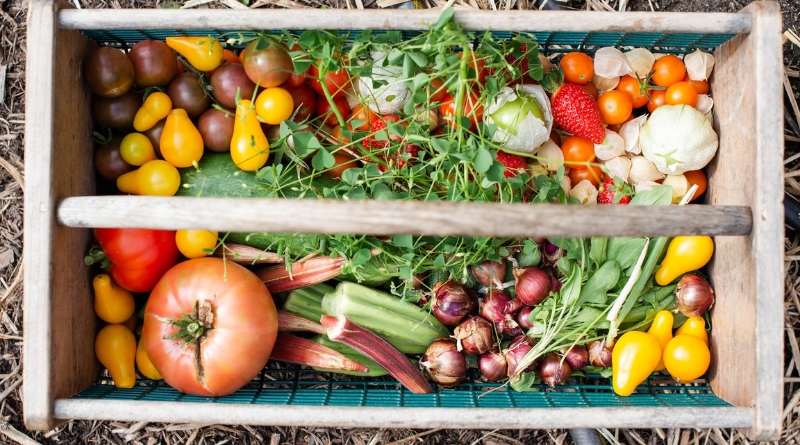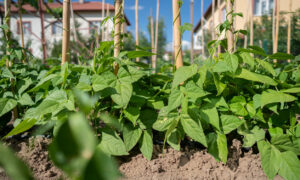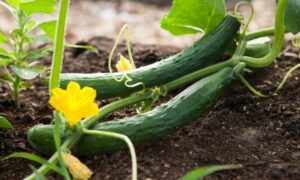We independently research, review, and recommend the best products. If you buy something through our links, we may earn a commission. Learn more.
Wouldn’t gardening life be simpler if there was a comprehensive guide to growing vegetables throughout the year? We think so. That’s why we’ve created a page for all the amateur veggie growers eager to produce nature’s bounty from the comfort of home.
We’ll journey through the months, stopping to discuss vegetables suitable for sowing (indoors and out) and harvesting in different seasons. There’s also heaps of information about vegetable care, when to move plants outdoors, and spacing advice along the way. Let’s get growing!
Contents
January

January—the dreaded month. It’s the time when many of us go back to work feeling the blues, but now is a great time to plan and prepare your vegetable garden for the upcoming growing season. That’s surely something to feel excited about! While most vegetables aren’t suitable for sowing in January’s frost, don’t let that dissuade you from prepping indoor seeds heading into spring.
Why not use this time to plan your garden layout, order seeds, and prepare your soil by mixing in compost or other organic material? Now’s the time to test soil pH levels — ensure it’s between 6.0-7.0.
If last year’s crop included lettuces, radishes, or other hardy vegetables, they may be ready to harvest—just ensure they’re left in the ground long enough to mature.
Sow in January:
- Microgreens, chillies, aubergines, and peppers.
- Tomatoes (under cover).
- Garlic (outside).
February
Spring is still a few months away and the garden is still experiencing frost. However, it is never too early to get ready for the new growing season. You can continue your preparations from January by checking your composting and constructing any necessary undercover growing areas. Take the opportunity to create new growing areas and consider minimising disturbance to the soil.
Prepare existing growing areas by mulching with organic matter, such as compost or manure. Start chitting potatoes and sow peppers, beetroot, French beans, and peas indoors. Your lettuce and spinach might also be ready to harvest from last season. So, not use this as an opportunity to get your tools in order?
Sow in February:
- Spinach, peas, broad beans, chillies, tomatoes, cucumbers and aubergines (under cover).
- Garlic outside.
March
You’ve made it to the month of transition! Spring is beginning to awaken your garden from its winter slumber and, although the weather may still be chilly, things are slowly coming back to life.
To prepare for the coming growing season, consider the last frost date in your area (we’ve got a handy frost date calculator here), as it will determine when it is safe to plant different crops. If the soil isn’t waterlogged or frozen, you can plant alliums, such as onion, garlic and shallots. As for direct sowing, early carrots, parsnips, lettuces and other leafy greens can be planted under cloches or in more protected, warmer areas. If you want to get a head start, consider sowing cucumber, celery or peppers indoors. Why not also use this month as an opportunity to create wildlife-friendly features in your garden, such as a pond?
Digging, unless you have light sandy soil, should be finished in March. Remember that applying rich compost or manure to land intended for root vegetables may encourage the roots to produce more than one growing point. With drier soil conditions, warmer weather, and increased light, many more vegetables can be started.
Sow in March:
- Aubergines, chillies and tomatoes (under cover).
- Broad beans, peas, beetroot, Swiss chard, radish, kale, spinach, spring onions, first early potatoes (outdoors).
- Shallot, onion sets and salad leaves (under fleece or a cloche).
April
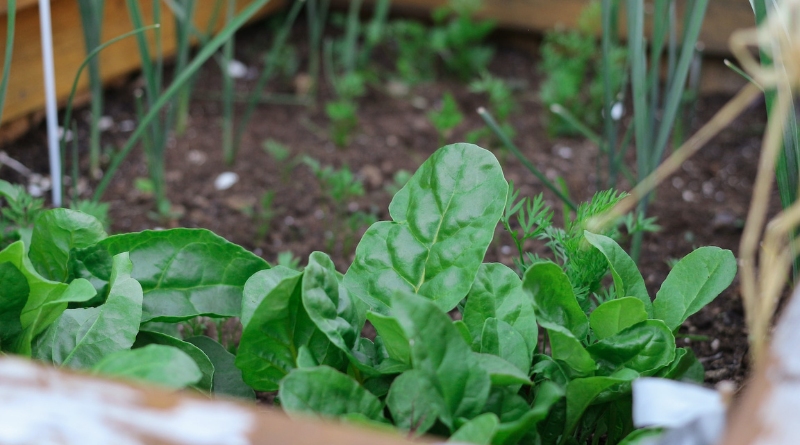
April marks the beginning of a busy time in the garden as the weather warms and the soil is ready for planting. Start direct sowing cool-season crops, such as radishes, carrots, parsnips, beetroot, and broad beans, and harden off seedlings sown indoors or undercover. For a steady harvest, continue sowing lettuce, radishes, and other quick crops under cover. Also sow companion crops like herbs and prick out and pot up seedlings.
Plant out potatoes, and provide a structure for peas to climb using sticks or other supports. Thin direct-sown carrots, radishes, parsnips, and beetroot, offering the remaining roots space to grow. Keep weeding in check and apply mulches to minimise infestations. If you’re using a greenhouse or polytunnel, make sure it is clean, water more frequently as the weather warms, and start opening the doors for ventilation on sunny days.
Sow in April:
- Aubergines, chillies and tomatoes.
- Courgettes, squashes, pumpkins, marrows and leeks (under cover).
- Beetroot, carrot, celeriac, peas, radish, lettuce, spinach, Swiss chard, broad beans, spring onions, second early and maincrop seed potatoes.
May
The month of opening windows and basking in the warm air—May! Now’s the time to keep your soil healthy, prevent weed growth, and start harvesting new veggies. But it’s not all hoeing; it’s also an opportunity to start planting and sowing seeds for a summer full of fresh produce.
Get ready by planting out half-hardy plants like aubergines, peppers, and tomatoes, but remember to harden them off first. And don’t forget to give your tomatoes a little extra love by feeding them. May is also a great time to get brassicas and other crops started indoors into their final positions.
With new vegetables like cabbages, spring onions, and radishes starting to mature, it’s important to make room for them by thinning out seedlings—but don’t let them go to waste! And don’t forget to give your peas some support as they grow.
Sow in May:
- Beetroot, purple sprouting broccoli, spinach, lettuce, peas, radish, carrots, spring onions (outside).
- Sweetcorn, cucumber, runner beans and courgettes (under cover at the start of the month, outside toward the end of the month).
- Courgettes, squashes and pumpkins (under cover).
June
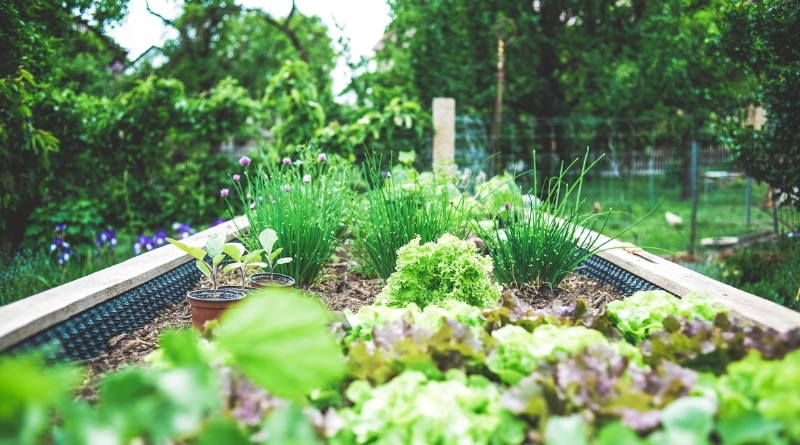
As the weather starts to warm up, your vegetables will start to fill out. To help keep them healthy, water thoroughly every few days with a fine spray. If you are short on time or water, give priority to seedlings, along with plants growing in pots, tubs, and frames.
When it comes to sowing, June is the time to keep succession sowing salad crops and make a last planting of French beans and peas. If you want to extend the season, protect the plants with cloches as the weather starts to cool. Now is also a great time to start sowing root vegetables like carrots, beetroot, and kohlrabi for a winter crop. Thinning, planting out, and transplanting will become the main focus as the month progresses.
Remember that some vegetables are more sensitive to warm weather than others, so pay extra attention to tomatoes, lettuce, celery, radishes and other less drought-tolerant plants. When planting, give outdoor tomatoes the sunniest and most sheltered spot you can find, and make sure to stake them if needed.
Brassicas like broccoli, kale, and cauliflower should be planted out once they have four or five true leaves. Also continue tying in runner beans, checking pea supports, and staking plants like Jerusalem artichokes as necessary.
Sow in June:
- Lettuce and radish weekly.
- Beetroot, peas, runner, French beans, spring onions, courgettes, lettuce, carrots, purple sprouting broccoli.
July
July is a busy month for growing vegetables in the garden. This is your last chance to sow French beans, but there’s still plenty of opportunity to plant fast-growing veggies such as radish, spring onions, and beetroot. July is also the time to reap the rewards of your hard work, with an abundance of crops ready to be harvested, including carrots, tomatoes, cucumbers, and more.
To extend the growing season, sow seeds for late-harvest crops like beans, carrots, and cauliflower. Remember to maintain the soil with compost and remove any finished early-season crops, while continuing to stake tomatoes and other plants. Watering is key in the summer months, so be sure to give the soil a deep soak, especially in the early morning when evaporation is low.
July is also the time to be vigilant with weed control, as weeds compete with your plants for water and nutrients. Keep an eye on mulch and top off any areas that have thinned. And don’t let all that hard work go to waste – harvest daily and share your bounty with friends and family. A handy trick is to use an old plastic laundry basket as a makeshift colander to collect your ready-to-pick produce.
Sow in July:
- Runner beans, Swiss chard, kale, winter cabbage, spinach, spring onions, winter potatoes, radishes, beetroot, lettuce, radish.
August

I hope you’ve had a summer holiday, because things are about to get busy in August as the heat of the month leads to a bountiful harvest and a chance to plant winter crops. Use this as an opportunity to sow seeds for spinach, kohl rabi, spring cabbage, and hardy lettuce to extend your cropping season into early autumn.
In August, the vegetable plot will be at its peak, with a glut of produce ready to harvest. But don’t forget to provide additional water to seedlings and newly planted plants during periods of dry weather. The sweetcorn is high, and the cobs will soon be ripe and ready. Remember to pinch out the growing tips of runner beans, and stop tomato plants to encourage fruit to ripen. Keep the garden healthy with regular watering and pest control — aphids and blackflies are abundant during this period.
Sow in August:
- Lettuce, rocket, spring onion, radish, plus winter salads, including mibuna, mizuna, and mustard leaf.
September
September marks the beginning of autumn, and gardening jobs now focus on preparing for the winter months. Activities will include sowing overwintering vegetables (such as spinach), planting onion sets, and covering spring cabbages with horticultural fleece.
Garlic and broad beans are two ideal crops to plant in September as they mature earlier the following spring and summer. When planting broad beans, be sure to protect the plants with fleece during harsh weather conditions. In addition, you could sow turnips for quick growth in around six weeks! I recommend sowing spinach for pickings next spring, covering it with fleece or a low cloche from October.
As the month progresses, vegetable ripening times will become longer. So, make sure to pick all ripe vegetables, such as tomatoes, peppers, beans, and other tender plants before the first hard frost. In certain mild-winter regions, you can plant cool-season vegetables, such as beets, broccoli, Brussels sprouts, carrots, and cauliflower.
Sow in September:
- Spinach, winter salads, radish.
October

In October, gardening activities thrive as the weather turns colder and the first frosts arrive. Take advantage of this time to evaluate your soil and make necessary improvements, such as turning heavy clay soil or planting green manures. This month is ideal for planting spring cabbages, onion sets, garlic cloves, and rhubarb crowns.
For a bountiful harvest, sow salad mixes, overwintering broad beans, peas, and cauliflower cultivars. Pumpkins and squashes should be ready for Halloween, while ripe tomatoes will await in drawers or boxes. Don’t forget to lift and store leeks, potatoes, and Florence fennel bulbs before frost sets in.
Get a jump on spring by sowing winter lettuce, short rows of winter-hardy peas, and broad beans. Remember, rough dig heavy ground, but avoid digging if the soil is wet or frozen.
Sow in October:
- Winter salads, peas, and garlic.
November
November is the time to spruce up your vegetable garden. Start by bidding farewell to old crops, storing them away before the frost sets in. Then it’s time to reap the rewards: plump Brussels sprouts, leeks, cabbage, and parsnips (that are even sweeter after a frosty kiss). Sow some pea seeds, transplant broad beans, and get ready to grow some tasty spring onion, pak choi, and winter salads. And don’t forget to plant onion, shallot, garlic, asparagus, and spring cabbage.
Give your garden a good tilling and add in some well-rotted organic matter for extra nutrition. Plant parsnips, garlic cloves in modules, and sow broad beans for overwintering. And don’t forget to prep for winter – check heaters, secure loose items, make leaf mould, and sow indoor herb seeds.
Sow in November:
- Garlic, onions, shallots, and broad beans.
December

If you’ve got well-drained soil, get ahead on the growing season by planting shallots and garlic. To protect your plants from pests, it’s important to place mice controls near stored vegetables and use slug controls. Keep brassicas safe from pigeons with cloches, netting or fleece, and remove yellowed leaves from Brussels sprouts and other brassicas to prevent the growth of grey mould and brassica downy mildew.
December is also a prime time to sow seeds, either directly in the ground or in a heated propagator indoors. This can result in earlier harvests and less empty space in your garden. However, shorter daylight hours can make it difficult to provide enough light for indoor seedlings. A grow lamp and a heated propagator can solve this problem and help you grow chillies, aubergines, and other crops.
For outdoor planting, sow broad beans directly in the ground if conditions are mild, or in a greenhouse or windowsill if they’re not. Boxing Day is a traditional day to sow onion seeds, which can be started off in pots indoors or undercover. In mild areas, plant garlic sets outdoors, or in a multi-celled tray if you have heavy soil.
Sow in December:
- Garlic and microgreens.
How to space and grow vegetables
Beetroot
Sow seeds outdoors 30cm between rows, thinning plants to 10cm apart. Pick when small before they turn woody. You can eat the young leaves in salads!
Carrots
Make early spring sowings under a cloche. Leave 30cm in between rows, thinning plants to 2cm apart. Cover plants to deter carrot fly pests.
Courgette
Sow seeds indoors, or in a sunny spot outdoors after the last frost, spacing plants 90cm apart. Mulch around plants and keep well watered.
French Beans
Sow indoors, planting out after the last frost. Make later sowings outdoors under a cloche. Space plants 15cm apart and keep them well watered.
Lettuce
Sow in moist soil 25cm between rows, thinning plants to 10cm. You can eat the thinnings! Make sowings once a week for a continuous supply, covering with fleece in cold weather.
Peas
Sow early indoors. When outdoors, space 90cm between rows with plants 5cm apart. Support plants with pea sticks and cover them with fleece to deter mice and pigeons.
Peppers
Sow seeds indoors. Wait until the last frost to plant them outside into containers on a sunny patio. To encourage bushy growth, pinch out the growing tips when plants are 20cm tall.
Potatoes
Choose blight resistance varieties, including Setanta, Nicola and Cara. Dig plenty of organic matter into the soil. Plant 12cm deep, 40cm apart with 60cm between rows. As plants grow, bank up the soil to cover the stems. Remember to water well.
Radishes
Sow every 3 weeks outdoors, 15cm between rows. Thin plants to 3cm for a continuous supply. Pick young before they turn woody.
Rocket
Grow as a cut-and-come-again crop. Sow outdoors 45cm between rows, thinning plants to 23cm apart. Keep well watered and mulch around the plants to seal in moisture.
Runner Beans
Dig lots of organic matter into the soil before sowing. Sow runner beans indoors, or in a sunny spot outdoors after the last frost. Grow plants up a wigwam of tall canes and keep well watered.
Spinach
Grow as a cut-and-come-again crop. Sow outdoors after the last frost, keeping 30cm between rows. Thin plants to 15cm. Sow seeds every 3 weeks for a continuous supply, covering with a fleece in cold weather.
Spring Onions
Make sowings every 3 weeks for a continuous supply outdoors, keeping 15cm between rows. There’s no need to thin the plants, just make sure to cover with a fleece in cold weather.
Sweetcorn
Sow indoors, planting out after the last frost in a sunny spot. As sweetcorn is wind pollinated, group plants in a block, spaced 45cm apart. Water regularly, especially during dry spells.
Tomatoes
Sow indoors, then plant out 45cm apart in a sunny spot. Tie single-stemmed varieties to a cane for support and pinch out the sideshoots which appear just above the leaf joint.
